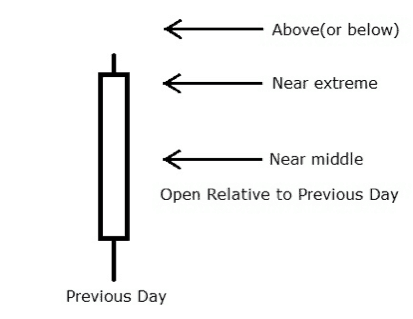- May 20, 2019
- Posted by: Mark S
- Categories: Trading Article, Trading Tutorials

Every market that you trade will constantly shift from balance to imbalance, consolidation ranges to directional movement looking for higher or lower price points.
The most relevant and new information we have about the possible acceptance of price is by comparing the open and the market’s reaction to yesterday’s price range.
While today may be a new day, you should take a moment to look back at yesterday and see how your instrument did.
What Does “Price Range” Mean?
When you think of price range, many traders will think of the average true range trading indicator. While the ATR is useful, for the purpose of comparing the open of today with the range of yesterday, we will resort to looking at the actual price.

The range of price is a measurement of the high and low and while we can see all aspects of the daily candlestick on the left, we don’t know what cam first.
It is possible that the market opened, sold off, pushed to new highs, and then closed off the highs as shown on the right.
Another way that price could have evolved throughout the day is:
- Market opened and pushed to new highs
- Market sold off to form the daily low
- Some time through the session, price rallied to close just off the highs
How price evolved to form the daily candlestick may be important to traders depending on their trading strategy.
What Is Price Acceptance?
Depending on which methods you use to analyze the markets, the answer to this may vary. Broadly speaking, it is persistent trading of a market at the same prices as were previously traded. If the market spends a reasonable amount of time at these prices without encountering any major activity to move it to new prices, this can be considered acceptance to some degree.
This doesn’t necessarily mean that price won’t deviate from accepted areas, just that the trading activity is more likely to be balanced than imbalanced which means the range of price will be lower.
The three different positions indicated here highlight whether on market opening, the perception of value has changed.

Market opens near the middle of previous days range
It is likely that there is little difference at least initially and unless information comes out which creates an imbalance, trading can overall be expected to be somewhat balanced around the same range.
Opens above or below previous days range – near extreme
The immediate possibility is that something may have already changed. The key is to look for acceptance or rejection of the new prices.
If the market opens outside of the prior day’s range, does it spend time trading there or is price quickly moved back into the known area of the prior day?
- Acceptance gives rise to (and could in itself be) a further move in the direction of the change.
- Rejection and a move back into the prior day’s range followed by acceptance of that range, could well give rise to a further move into the same range. After all, if the balance is still intact, then prices on the extreme will be viewed as expensive or cheap depending on which end price sits.
- If the market opens below, maybe a counter trend trading strategy would come in handy
So why does that matter to you and your strategy?
Comparing the open to yesterday’s range can give us all an early indication of whether anything has changed and so what the directional bias may or may not be.
With this knowledge in hand, setups of any kind occurring in the same direction, stand a greater chance of achieving a successful outcome.
